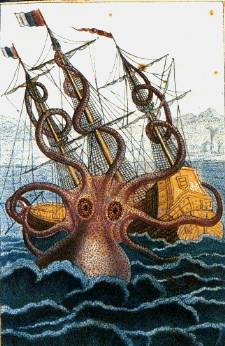The journal Nature reports that a team of ocean researchers have captured the world’s first video of a giant squid (Architeuthis dux) in its natural environment. The video was captured 700 meters (2300 feet) beneath the Pacific near the Ogasawara archipelago, about 1000 kilometers south of Tokyo Japan. The mission was funded by Japan’s NHK broadcasting commission and the US-based Discovery Channel, both of which will air programs about the giant squid encounter later this month.
Widder’s camera relied on a dim light in the red, near-infrared range. And you can see the results for yourself here:
[youtube]http://www.youtube.com/watch?v=uLRY1cNxL1I[/youtube]
Sailors have known about giant squid for centuries. But ancient whalers and fishermen didn’t carry video equipment and so their fish stories were filed with tales of dragons, mermaids and other sea monsters. The Nordic tales of a sea monster named Kraken may have been based upon rare sightings of the giant squid.
It doesn’t help our believability that these tales were often exaggerated. The Kraken was said to reside in the deep ocean and attract many fish to itself. It was said to only briefly rise to the surface. So far this sounds very much like a giant squid, but the Kraken was also said to be so large that it was sometimes mistaken for an island. Its mouth was described to gape as large as the entrance to a fjord.
Well, fish stories are known for their exaggerations. The giant squid is estimated to grow as large as 15 meters (50 feet) in length, not quite the size of a fjord but something sure to frighten the daylights out of sailor. In his poem, The Kraken (1830), Alfred Tennyson writes:
Below the thunders of the upper deep;
Far far beneath in the abysmal sea,
His ancient, dreamless, uninvaded sleep
The Kraken sleepeth: faintest sunlights flee
About his shadowy sides; above him swell
Huge sponges of millennial growth and height;
And far away into the sickly light…
In 20,000 Leagues Under the Sea, Jules Verne writes:
“I stared in my turn and couldn’t keep back a movement of revulsion. Before my eyes there quivered a horrible monster worthy of a place among the most farfetched teratological legends. It was a squid of colossal dimensions, fully eight meters long. It was traveling backward with tremendous speed in the same direction as the Nautilus. It gazed with enormous, staring eyes that were tinted sea green.
Its eight arms (or more accurately, feet) were rooted in its head, which has earned these animals the name cephalopod; its arms stretched a distance twice the length of its body and were writhing like the serpentine hair of the Furies. You could plainly see its 250 suckers, arranged over the inner sides of its tentacles and shaped like semispheric capsules. Sometimes these suckers fastened onto the lounge window by creating vacuums against it. The monster’s mouth–a beak made of horn and shaped like that of a parrot–opened and closed vertically. Its tongue, also of horn substance and armed with several rows of sharp teeth, would flicker out from between these genuine shears. What a freak of nature!”
Like the monster which attacked Captain Nemo’s submarine and the mythical Kraken, the giant squid spends much of its life in the silent darkness of the deep ocean. This is one reason so few have seen it alive. Occasionally a dead one would wash ashore but because this creature is adapted to cold high pressure water of the deep ocean, it quickly decayed on the surface as Tennyson’s poem ends:
Then once by man and angels to be seen,
In roaring he shall rise and on the surface die
Other clues to the giant squid’s existence are the scars its suckered tentacles leave on sperm whales. These squids are thought to be the only predator large enough to take on a beast of this size.
The first photograph of a giant squid in its native environment was taken by Tsunemi Kubodera of the National Science Museum in Tokyo and Kyoichi Mori of the Ogasawara Whale Watching Association in this same region of the Pacific ocean in the autumn of 2004.
The video taken by this more recent expedition relied on a camera system invented by Edith Widder, founder of the Ocean Research and Conservation Association in Fort Pierce, Florida. Widder believes that the key to this mission’s success was the focus on the squid’s keen sense of sight. Giant squids are accustomed to the darkness of the deep ocean, their eyes, the size of dinner plates, are sensitive to the dim light of bioluminescent prey, so bright camera lights would disturb it and possibly frighten it away.





The primary video that was shot for the Discovery Channel’s upcoming series was shot by Tsunemi Kubodera, his cameraman, and Jim Harris piloting the vehicle, a Triton 3300 submersible.